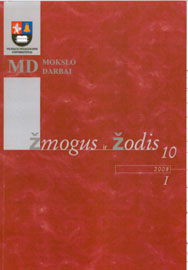Lietuvių kalbos fonologinio skiemens struktūrinių modelių dažnumas
Frequency of stuctural types of phonological syllables in Lithuanian
Author(s): Asta Kazlauskienė, Gailius RaškinisSubject(s): Language and Literature Studies
Published by: Vytauto Didžiojo Universitetas
Keywords: syllable; nucleus of a syllable; short and long syllables; open and closed syllables; covered and uncovered syllables; initial and final clusters of consonants.
Summary/Abstract: Previously, structural models of Lithuanian syllables have been investigated by A. Pupkis and M. Strimaitienė. An extensive generalized description of their work was produced by A. Girdenis. In this article, we focus on the frequency of structural types of Lithuanian syllables. Over 311 thousand of phonological syllables (about 109 thousand of word tokens) taken from the VMU Corpus of Contemporary Lithuanian Language were analysed. The investigations revealed that Lithuanian is dominated by open covered syllables: CeV/Vv (71 %), CeV/VvCi (21 %), V/VvCi and V/Vv (4 % and 4 %). 25 generalized types of phonological syllables were found in our data. These generalized types were expressed by 148 syllable structures. The type CV covered 54 % of all syllable tokens. Three the most frequent types (CV, CVC and CVv) comprised 79 % of all syllable tokens. Ten most frequent types covered 99 % of all syllable tokens. The analysis confirmed once again that Lithuanian is dominated by the open syllables of the CV type. Consonants preceding the nucleus of a syllable (if there are any) can number from one to three. Their frequency differed significantly. Single consonant preceded the nucleus of a covered syllable in 88 % of the cases (sonorant, plosive, and fricative consonants were found to have frequency of 39 %, 39 %, and 10 % respectively). A pair of consonants preceded the nucleus of a syllable in 11 % of all instances: TR (5 %), ST (4 %), SR (2 %). Three consonants (of STR type) preceded the nucleus of a syllable in just 1% of all cases. Closed syllable was usually terminated with a single consonant (95 % cases). Sonorant, fricative, and plosive consonants were found within these cases with the frequencies of 42 %, 38 %, and 15 % respectively. Closed syllable was terminated with a pair of consonants in 5 % of all cases: RT (3 %), RS (2 %). Other pairs of terminal consonants belonging to such types as RR, ST, TS, TT were very rare. Cases where the nucleus of a syllable was followed by three consonants (RST, RTR, RTS, RTT, TST) fell below 1%.
Journal: Žmogus ir žodis
- Issue Year: 10/2008
- Issue No: 1
- Page Range: 24-31
- Page Count: 8
- Language: Lithuanian

